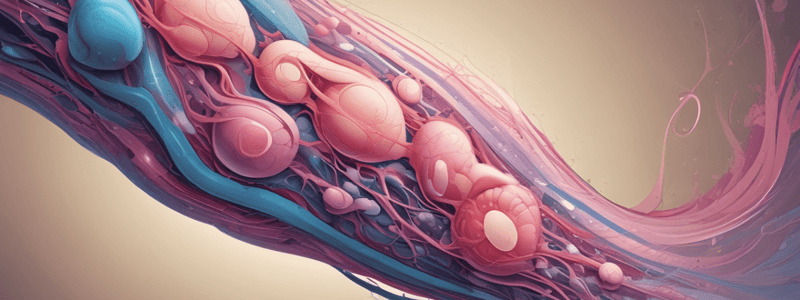Podcast
Questions and Answers
What is the primary characteristic of asexual reproduction?
What is the primary characteristic of asexual reproduction?
- Production of offspring that are genetically identical to the parent (correct)
- Production of offspring with unique genetic combinations
- Production of multiple batches of offspring
- Combination of genetic material from two parents
Which structure is responsible for producing eggs in the female reproductive system?
Which structure is responsible for producing eggs in the female reproductive system?
- Uterus
- Ovaries (correct)
- Vagina
- Fallopian tubes
What is the term for the production of gametes through meiosis?
What is the term for the production of gametes through meiosis?
- Embryogenesis
- Gametogenesis (correct)
- Fertilization
- Organogenesis
Which reproductive strategy is characterized by producing many offspring with minimal parental investment?
Which reproductive strategy is characterized by producing many offspring with minimal parental investment?
What is the term for the fusion of sperm and egg to form a zygote?
What is the term for the fusion of sperm and egg to form a zygote?
Which type of reproductive barrier prevents mating between different species?
Which type of reproductive barrier prevents mating between different species?
What is the term for the development of organs and body systems in a developing embryo?
What is the term for the development of organs and body systems in a developing embryo?
Which reproductive system produces sperm through meiosis?
Which reproductive system produces sperm through meiosis?
What is the term for the production of multiple batches of offspring throughout a lifetime?
What is the term for the production of multiple batches of offspring throughout a lifetime?
Which stage of reproduction involves the growth and maturation of the fetus?
Which stage of reproduction involves the growth and maturation of the fetus?
Study Notes
Reproductive Modes
- Asexual reproduction: A single parent produces offspring that are genetically identical to the parent. Examples: binary fission, budding, fragmentation.
- Sexual reproduction: Two parents combine genetic material to produce offspring with a unique combination of genes. Examples: meiosis, fertilization.
Human Reproductive System
- Male reproductive system:
- Produces sperm through meiosis
- Structures: testes, epididymis, vas deferens, prostate gland, urethra
- Female reproductive system:
- Produces eggs through meiosis
- Structures: ovaries, fallopian tubes, uterus, cervix, vagina
Stages of Reproduction
- Gametogenesis: Production of gametes (sperm or eggs) through meiosis
- Fertilization: Fusion of sperm and egg to form a zygote
- Embryogenesis: Development of the zygote into an embryo
- Organogenesis: Development of organs and body systems
- Fetal development: Growth and maturation of the fetus
Reproductive Strategies
- R-selection: Produce many offspring with minimal parental investment (e.g., fish)
- K-selection: Produce few offspring with high parental investment (e.g., humans)
- Iteroparity: Produce multiple batches of offspring throughout a lifetime (e.g., most mammals)
Reproductive Barriers
- Prezygotic barriers: Prevent mating between different species (e.g., differences in courtship displays)
- Postzygotic barriers: Prevent hybrid offspring from surviving or reproducing (e.g., sterility, inviability)
These notes provide a concise overview of the key concepts and processes involved in reproduction, including the different modes, reproductive systems, stages of reproduction, reproductive strategies, and reproductive barriers.
Reproductive Modes
- Asexual reproduction: Produces offspring genetically identical to the parent, occurring through mechanisms such as binary fission, budding, and fragmentation.
- Sexual reproduction: Combines genetic material from two parents to produce offspring with unique gene combinations, involving processes like meiosis and fertilization.
Human Reproductive System
- Male reproductive system: responsible for producing sperm through meiosis, with key structures including testes, epididymis, vas deferens, prostate gland, and urethra.
- Female reproductive system: produces eggs through meiosis, with key structures including ovaries, fallopian tubes, uterus, cervix, and vagina.
Stages of Reproduction
- Gametogenesis: Production of gametes (sperm or eggs) through meiosis.
- Fertilization: Fusion of sperm and egg to form a zygote.
- Embryogenesis: Development of the zygote into an embryo.
- Organogenesis: Development of organs and body systems.
- Fetal development: Growth and maturation of the fetus.
Reproductive Strategies
- R-selection: Produces many offspring with minimal parental investment, examples include fish.
- K-selection: Produces few offspring with high parental investment, examples include humans.
- Iteroparity: Produces multiple batches of offspring throughout a lifetime, examples include most mammals.
Reproductive Barriers
- Prezygotic barriers: Prevent mating between different species, examples include differences in courtship displays.
- Postzygotic barriers: Prevent hybrid offspring from surviving or reproducing, examples include sterility and inviability.
Studying That Suits You
Use AI to generate personalized quizzes and flashcards to suit your learning preferences.
Description
Understand the basics of asexual and sexual reproduction, and learn about the male reproductive system in humans.



